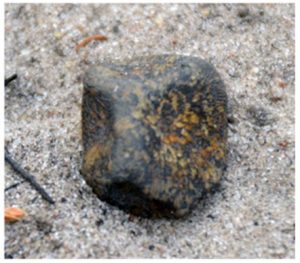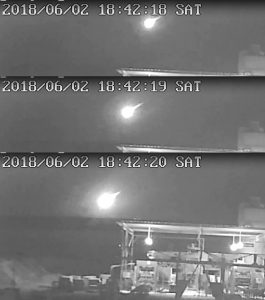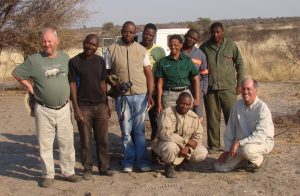April 2021
 Meteorite MP-19, found by Tim Cooper in Central Kalahari Game Reserve on October 12, 2018. Image courtesy Dr Peter Jenniskens.
Meteorite MP-19, found by Tim Cooper in Central Kalahari Game Reserve on October 12, 2018. Image courtesy Dr Peter Jenniskens.
Almost three years since the entry of asteroid 2018 LA into the atmosphere over Botswana on June 2, 2018, the scientific results generated by sixty-six authors, collectively known as the ‘2018 LA Consortium’, and after an in-depth analysis of the recovered meteorites from 2018 LA, are now out in an article in Meteoritics and Planetary Science.
Discovered just a few hours earlier, asteroid 2018 LA entered earth’s atmosphere at 16h44 UT, and resulted in a bolide which reached magnitude -23 during its disruption at an altitude of 27.8 km. The resultant explosion deposited meteorites over a strewn field located in the northern part of the Central Kalahari Game Reserve (CKGR) in Botswana. Several videos were secured which captured the visible passage of the bolide, including the bright explosion, which enabled a precise determination of the location at which the disruption occurred. The screen grabs at right show the passage as seen from a commercial property in Gaborone just prior to the disruption of the meteor.
 Left: Screen grabs of the bolide from a security camera in Gaborone. Images reproduced with kind permission of Beverly Lombard.
Left: Screen grabs of the bolide from a security camera in Gaborone. Images reproduced with kind permission of Beverly Lombard.
ASSA’s Tim Cooper calibrated videos of the bolide to help determine the location of the strewn field and also calibrated the footage which enabled photometry and subsequently the construction of the light curve of the meteor. An initial search during June 18-23, 2018 found one meteorite (MP-01), now referred to as Motopi Pan. Following revised astrometry, a new search was mounted with a team comprising members from the Botswana Geophysics Institute, Okavango Research Institute, Department of National Museum and Monuments (Botswana), the Department of Wildlife & National Parks, the Astronomical Society of Southern Africa (ASSA) and under the guidance of meteor astronomer Dr Peter Jenniskens from the SETI Institute. The search during October 9-12, 2018 found an additional 22 fragments of asteroid 2018 LA, all collectively known as Motopi Pan, and including fragment MP-19 (image top left) found by Tim Cooper on October 12, 2018. The discovery of these fragments now enabled a complete characterisation of the meteorites from asteroid 2018 LA, and determination of its origin in the solar system.
 Left: Rubria Crater on asteroid 4 Vesta, probable source of the meteorites from 2018 LA. Image credit NASA/JPL-Caltech/UCLA/MPS/DLR/IDA
Left: Rubria Crater on asteroid 4 Vesta, probable source of the meteorites from 2018 LA. Image credit NASA/JPL-Caltech/UCLA/MPS/DLR/IDA
Following extensive analysis using multiple techniques, these show the Motopi Pan meteorite to be a HED polymict breccia derived from howardite, eucrite, and diogenite lithologies.
The findings and pre-atmospheric orbit are consistent with an origin for Motopi Pan at asteroid 4 Vesta, possibly from the 10 km crater Rubria (left image) during an impact ~22 Ma ago.
The full scientific results and findings can be found in the Meteoritics and Planetary Science article. The full story of the appearance of the bolide, eye-witness accounts, analysis of video footage to determine the strewn field location, measurement of the brightness of the meteor, and the October 2018 search for meteorites from asteroid 2018 LA will appear in the June issue of MNASSA.
Members of the October 2018 search team which found an additional 22 fragments of the Motopi Pan meteorite. Standing left to right Tim Cooper (ASSA), Oliver Moses (ORI), Mohutsiwe Gabadirwe (BGI), Thebe Kemosedile (ORI), Sarah Tsenene (DWNP), Kabelo Dikole (BGI), Mosarwa Babutsi (Botswana National Museum, Gaborone), kneeling Kagiso Kgetse (DWNP) and Peter Jenniskens (SETI Institute). ASSA = Astronomical Society of Southern Africa, BGI = Botswana Geoscience Institute, ORI = Okavango Research Institute of the University of Botswana at Maun, DWNP = Department of Wildlife and National Parks. Photo by team member Odirile Sempho.

